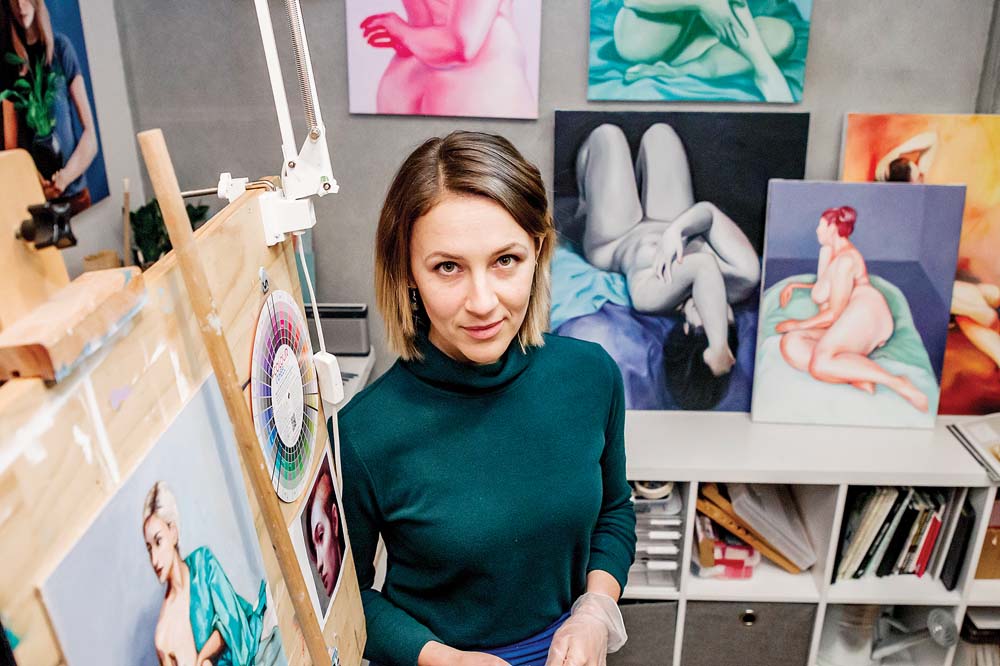
By Keith Platt Photos Yanni & supplied
IT would be easy for audiences to miss the nuances that go into the staging of reality shows on TV.
Engrossed in the quick repertoire of contestants or by their sideways glances at their partners or opponents, the set – or in the case of Channel 9’s The Block, a building under renovation – can go relatively unnoticed.
But for Mornington-based artist, Maria Radun’s one decoration added to a master bedroom stood out like a shining light.
Sitting atop a chest of drawers on the show’s Sunday 25 August episode was one of Radun’s works, a painting of a nude woman she titled Folded.
It was a small thing compared to The Block’s overall presentation and its underlying dramas, but to Radun it signalled an acceptance and validation of her art.
Her studio in a building that to all outside appearances is a factory in Mornington’s light industrial area, is divided into rooms and leased to “creatives” at Black Spot Gallery and Studios. The space is a hive of industry for artists and designers and has enough room for exhibitions.
Radun’s contribution to The Block was achieved when contestants were able to choose artworks from the show’s nominated supplier, the online gallery Art Lovers Australia.
Watched by hundreds of thousands, Radun’s work was obviously spotted by some viewers and led to her social media “getting lots of engagement and a few more followers”.
“Some people have bought prints of the painting that was in the show, which is nice, and I’m still hoping for more sales and commissions,” Radun said, five days after the show went to air.
Now a full time artist, Russian-born Radun came to Australia with her family when she was 10, “an age when you’ve already made friends you care about deeply and you are very attached to your school and all your activities, but you’re not quite old enough to understand just what this kind of change means or know to ask for what you need”.
“Not knowing any English, the first few years were difficult. It was a strenuous time for the whole family, my parents worked hard to provide for me and my two brothers.”
However, she adapted to her new home and within two years was “talking to my Aussie friends without much of an accent”.
Radun credits the therapeutic and healing qualities of drawing and painting as having helped her settle in.
Dreaming of being an artist, Radun took the more practical course and studied design after leaving school.
“I also did illustration, where I could apply my drawing skills more directly, although image making was becoming highly digitised and the work more corporate rather than artistic.”
She worked as an illustrator and graphic designer during her 20’s, all the time keeping up a steady attendance at workshops and
life -drawing classes.
On turning 30, she decided to turn her dream into reality and enrolled in fine arts at Monash University.
Now a full time artist, Radun says she has spent the past few years developing a “personal approach” to portraits and the figures, “while studying the classical traditional techniques of painting”.
“Every painting is an attempt to evoke a sense of stillness and a contemplative mood that would draw the viewer into quiet conversation.”
Her painting of a nude woman, mostly hidden behind a large, tightly clutched cushion, is titled “The impermanence of comfort”.
Radun says her process often involves preliminary sketches and observational drawing to help develop composition and a better understanding of her subject.
Photographs can be a useful reference but are not “always as true to the real thing”. But they are “convenient, unchanging, detailed” and allow her to “take my time in the comfort of my studio”.
However, it is the play of light on a subject that always forms the basis for inspiration.
“I view figures, still life and landscapes as opportunities to explore the effects of light on form. As a former designer, I am also drawn to strong composition, balance and, of course, colour,” she says.
“I am intrigued by how we perceive ourselves through the eyes of others. I like to explore ideas relating to our relationship with our own bodies, drawing upon my own personal experience from the perspective of a woman in contemporary society.”
While enjoying “the personal connection, mutual understanding and empathy that develops between artist and the model”, Radun also often depicts herself, as she did with Folded, the work chosen by The Block contestants, Matt and El’ise.
“It’s probably common for artists to use themselves this way, as models are expensive,” she says
If sales and inquiries in the wake of The Block are any indication, the days of needing to use herself as a model may be drawing to a close.
